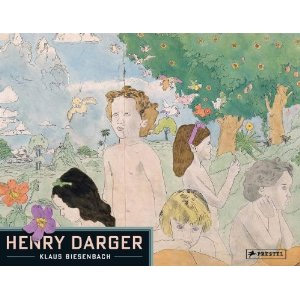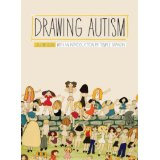
Klaus Biesenbach, editor.
Henry Darger.
Munich ; New York : Prestel in cooperation with the American Folk Art Museum, 2009.
Avery Fine Arts: ND239 D239 H38
The iconic American outsider artist is presented here in a new critical light, locating him for the first time as a major figure in the history of contemporary art. Self-taught and working in isolation until his death in 1973, Henry Darger realized an elaborate fantasy world of remarkable beauty and strangeness, through hundreds of paintings and an epic written narrative. This book examines the radical originality of Darger’s art, including his use of collage, incorporation of religious themes and iconography, and frequent juxtaposition of innocence with violence.
 Martina Weinhart and Max Hollein, editors.
Martina Weinhart and Max Hollein, editors.
Weltenwandler : die Kunst der Outsider = World transformers : the art of the outsiders.
Frankfurt : Schirn Kunsthalle : Ostfildern : Hatje Cantz, 2010.
Avery Fine Arts: N6494 P7 W46
This book presents a wide range of art by artists working beyond the bounds of conventional artistic production, ranging from the nineteenth century to the present day, including the dream worlds of Swiss artist Aloise; the precise mathematical utopias of George Widener; and the "Ewigkeitenendeland" (End-of-Eternities Land) of Austrian artist August Walla. Others represented here are A.C.M., Emery Blagdon, Darger, Auguste Forestier, Magde Gill, Karl Junker, Friedrich Schroder-Sonnenstern, Judith Scott, Oskar Voll, Adolf Wolfli and Birgit Ziegert.

Jill Mullin.
Drawing autism.
New York : Mark Batty Publisher, 2009.
Avery Fine Arts: N71 M93
First identified in 1943, autism has over the last decade become an international topic of conversation. Drawing Autism celebrates the artistry and self-expression found in the drawings, paintings, and collages created by people diagnosed with autism. The work of over fifty contributors exhibits an array of unique perspectives on how these individuals see the world and their place in it.
.jpg) The drawings of the electric pencil.
The drawings of the electric pencil.
[New York?] : Electric Pencil Press, 2010.
Avery-LC: N7432.5 .A78 D73 2010g
Around the year 1910, a patient at State Lunatic Asylum No. 3 in Nevada, Missouri, who referred to himself as The Electric Pencil, executed 280 drawings in ink, pencil, crayon and colored pencil. These beautiful drawings of animals, people and buildings were executed on both sides of 140 ledger pages, each bearing the name of the hospital in official type across the top, thus dramatizing the interface of the institutional and the creative. His many portraits–head-and-shoulders or just heads–feature formal, sometimes dazed-looking men and women with elaborate hats or razor-parted hair who stare out of the page with wide, piercing eyes in a manner that suggests both a possible chilling regime of "mental health" treatment and the unblinking, unsettling gaze of those who haunt the margins of sanity and society.
–by Paula Gabbard, Fine Arts Librarian; Chris Sala, Architecture Librarian; Jeffrey Ross, Indexer/Reference Librarian